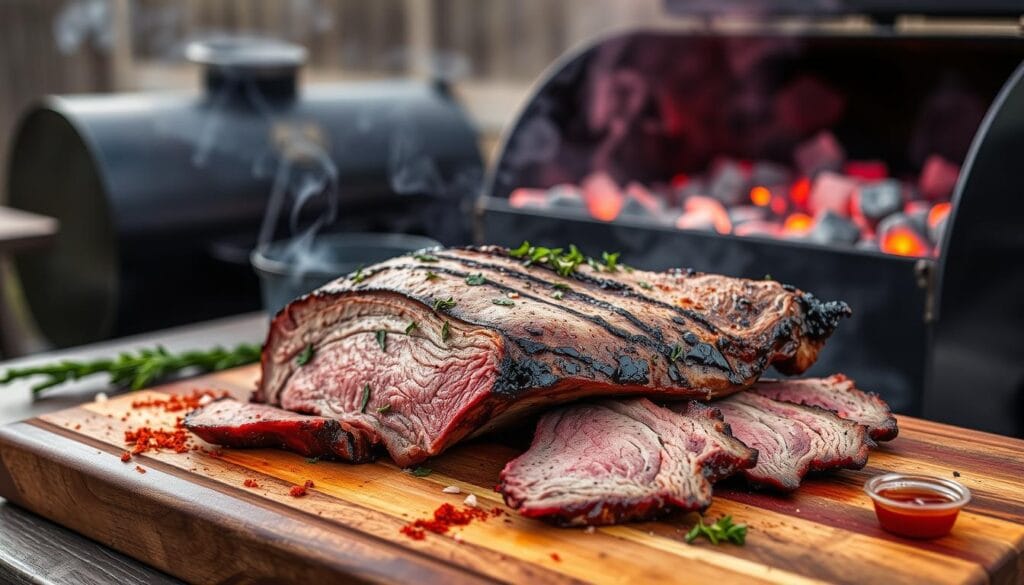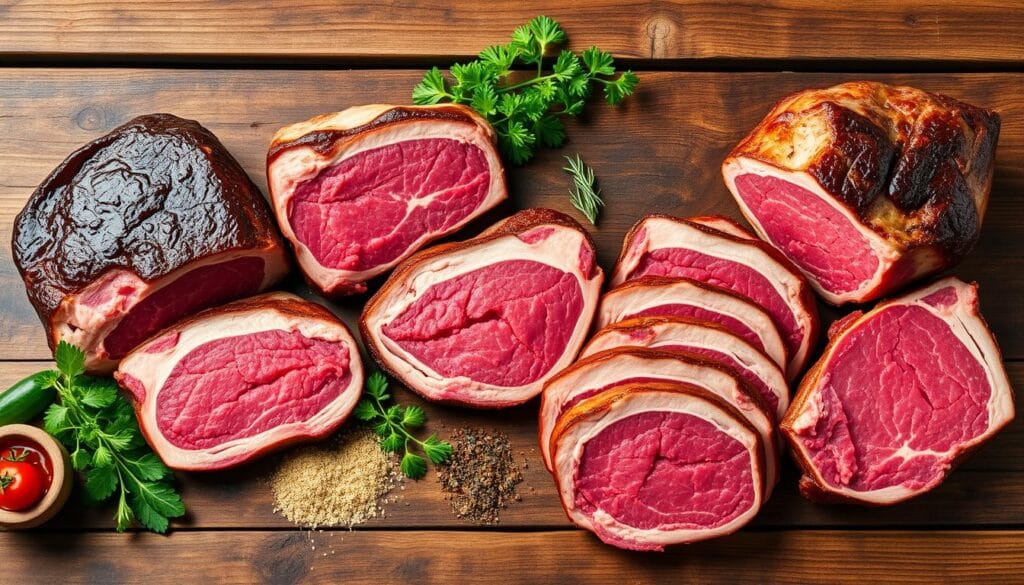Growing up in Texas, brisket was more than just a meal. It was a tradition that brought families together. Every backyard barbecue and family gathering revolved around this legendary cut of beef.
Wondering if beef brisket is healthy? You’re not alone. This flavorful cut from the cow’s breast offers a complex nutritional profile. It might surprise you with its potential benefits and considerations.
Understanding brisket’s health benefits requires a closer look at its composition. Rich in essential nutrients and protein, brisket can be a valuable addition to your diet. It’s important to consume it mindfully and use healthier cooking techniques.
Table of Contents
Nutritional Profile of Beef Brisket
Exploring brisket nutrition facts shows it’s packed with essential nutrients. Beef brisket has a rich nutritional profile that supports your diet and adds flavor.
For those watching their calories, knowing about beef brisket is key. A 100-gram serving has about 289 calories. It’s a big protein source for your meals.
Calories and Macronutrients
The macronutrient breakdown of brisket is interesting. Here’s what you’ll find:
- Protein: About 20 grams per 100-gram serving
- Total Fat: 18.42 grams
- Saturated Fat: Moderate levels
- Monounsaturated Fats: Good for your heart
Vitamins and Minerals
Brisket is more than just protein and calories. It’s full of nutrients that boost your health:
- Vitamin B12: Helps your brain and energy
- Zinc: Strengthens your immune system
- Iron: Essential for carrying oxygen
- Selenium: Good for your cells
*”Brisket provides a nutrient-dense protein option for those seeking balanced nutrition.”*
Enjoy brisket in moderation and cook it healthily. Grilling or baking are good methods. It can be a great part of a balanced diet.
Health Benefits of Beef Brisket
Beef brisket is more than just tasty. It’s packed with nutrients that boost your health. Knowing its benefits helps you choose better foods.
High in Protein Content
Brisket is great for building and keeping muscles strong. A 100-gram serving has about 26.1 grams of protein. This is key for:
- Muscle growth and repair
- Keeping energy up
- Feeling full longer
Rich in Essential Minerals
Brisket is not just high in protein. It also has important minerals for our bodies.
| Mineral | Health Benefit |
|---|---|
| Iron | Helps carry oxygen in blood |
| Zinc | Strengthens the immune system |
| Selenium | Protects against damage |
Source of Vital Nutrients
Brisket is full of B vitamins for brain health and energy. It also has taurine and CLA for extra benefits.
“Brisket, when consumed in moderation, can be a healthful addition to your diet.” – Nutrition Experts
While brisket is good for you, watch your portions and how you cook it. This keeps its health benefits.
Potential Health Risks of Beef Brisket
When thinking about if beef brisket is healthy, it’s key to know the health risks. This meat is tasty but has some nutritional points to consider.
Saturated Fat Content and Cardiovascular Concerns
Beef brisket has a lot of saturated fat, which can hurt your heart. Research shows that eating too much brisket fat can raise bad cholesterol. The fat that makes brisket tender can be a health risk if eaten too much.
- High saturated fat content can raise cholesterol
- Increased risk of cardiovascular disease
- Potential impact on overall heart health
Cooking Methods and Health Implications
How you cook beef brisket changes its nutritional value. Traditional smoking can add health risks. Some cooking ways may:
- Increase sodium content
- Potentially create harmful compounds
- Reduce essential nutrients
The key is moderation and smart preparation techniques.
Experts say to pick lean cuts and use healthy cooking like grilling or baking. This way, you can enjoy brisket while keeping your health in check.
How Beef Brisket Fits into a Balanced Diet
Adding beef brisket to your meals needs careful planning. A brisket diet can be good for you if done right. It’s important to control portions and choose the right sides for a healthy meal.
Mastering Portion Control
Controlling how much brisket you eat is key to a balanced diet. Experts say to limit brisket to:
- 3-4 ounces per meal
- Approximately the size of a deck of cards
- Lean cuts preferred for a low-fat brisket recipe
Creating Nutritious Meal Combinations
Pairing brisket with healthy sides makes your meal better. Try these options:
- Roasted vegetables
- Quinoa or brown rice
- Fresh green salads
- Steamed seasonal vegetables
“Moderation and balance are the secret ingredients to enjoying beef brisket responsibly.” – Nutrition Experts
To make your brisket diet work, choose leaner cuts and healthier cooking. Grilling, broiling, or baking cuts down fat while keeping flavor and nutrients.
A low-fat brisket recipe doesn’t mean you have to give up taste. By picking high-quality, lean cuts and being mindful in cooking, you can enjoy brisket without harming your health goals.
Alternatives to Beef Brisket
Looking for beef brisket alternatives? You can find many tasty and healthy options. They help you keep a balanced diet while enjoying great flavors and textures.
Wondering if beef brisket is healthy? Trying different cuts can give you similar nutrition with less fat.
Lean Beef Alternatives
Meat lovers, here are some healthier beef options:
- Chuck Roast: It’s affordable and full of flavor, just like brisket.
- Tri-tip: This cut is great for roasting and barbecuing.
- Short Ribs: They have a rich flavor, perfect for slow cooking.
- Beef Shanks: A budget-friendly choice that needs slow cooking.
Plant-Based and Other Protein Options
Want to eat less meat? These options are full of protein:
- Tofu: It’s high in protein and low in saturated fat.
- Legumes: Beans and lentils are full of nutrients.
- Seitan: Made from wheat, it has a meat-like texture.
- Pork Roast: There are different cuts for various cooking methods.
“Diversity in protein sources can help you maintain a balanced and nutritious diet.”
When picking alternatives, think about your nutritional needs and cooking style. Each option has its own benefits that can meet your dietary goals.
Cooking Techniques for Beef Brisket
When cooking beef brisket, it’s important to pick the right method. This ensures the meat is both tasty and healthy. Knowing the different techniques can help you make a delicious brisket that meets your dietary needs.
Smoking: A Flavorful Low-Fat Brisket Recipe Technique
Smoking beef brisket is a great way to make a low-fat dish. It takes about 5 to 6 hours to cook. The meat should reach 185°F to 190°F. Here are some tips for smoking:
- Use the 3-2-1 smoking method for optimal tenderness
- Maintain a consistent temperature around 225 degrees
- Choose wood chips that complement beef flavor

Braising: Tenderizing with Precision
Braising is a method that helps control fat while making the meat tender and flavorful. Here are some recommended steps:
- Start at 425°F for 1 hour 15 minutes
- Reduce temperature to 300°F for 2 hours 30 minutes
- Use minimal liquid to preserve nutritional value
Grilling: A Healthy Cooking Alternative
Grilling is a good choice for a low-fat brisket. It lets excess fat drip away.
| Cooking Method | Time | Temperature |
|---|---|---|
| Smoking | 5-6 hours | 225°F |
| Braising | 3-4 hours | 300-425°F |
| Grilling | 4-5 hours | 225-250°F |
“The key to a healthy brisket is not just the cooking method, but understanding how each technique impacts nutritional value.” – Culinary Nutrition Expert
Remember, no matter the method, controlling temperature and cooking time is key. It’s important for safety and keeping the meat’s nutrients.
Popular Dishes Using Beef Brisket
Beef brisket is incredibly versatile, turning into delicious dishes that excite our taste buds. Knowing about brisket nutrition facts helps us enjoy these tasty meals while keeping an eye on beef brisket calories.
Barbecued Brisket: A Texan Tradition
Barbecued brisket is a key dish in Texas-style cooking. Pit masters slow-cook it to make a smoky, tender masterpiece. A three-pound brisket feeds about eight people and needs careful preparation.
- Seasoning typically includes kosher salt, black pepper, and smoked paprika
- Cooking time averages three hours at 300°F
- Fat cap should be trimmed to ¼ inch thickness
Brisket Tacos: A Flavorful Fusion
Brisket tacos mix traditional barbecue with Mexican flavors. They show how versatile brisket is, turning leftover brisket into a lively, fulfilling meal.
| Dish | Serving Size | Calories | Protein |
|---|---|---|---|
| Barbecued Brisket | 6 oz | 582 | 42g |
| Brisket Tacos | 4 oz | 293 | 29g |
“Beef brisket isn’t just a meal, it’s a culinary adventure waiting to be explored.”
Whether you want smoky barbecue or zesty tacos, beef brisket offers rich flavors and good nutrition. Just remember to control your portion sizes and enjoy these dishes as part of a balanced diet.
Tips for Selecting Quality Beef Brisket
Choosing the right beef brisket is key for a tasty and healthy meal. Knowing about brisket nutrition facts helps you pick a brisket that fits your health goals.

When deciding if beef brisket is healthy, look at these important points:
Understanding Beef Grades
Beef grades affect meat quality and nutrition. Here’s a quick guide:
- Prime Grade: Highest fat content, most tender
- Choice Grade: Good marbling, balanced flavor
- Select Grade: Leaner option with less marbling
Freshness Indicators
Choosing a fresh brisket means better taste and nutrition. Here are signs of freshness:
| Indicator | What to Look For |
|---|---|
| Color | Bright red meat, avoid gray or brown discoloration |
| Fat | White or cream-colored fat |
| Marbling | Fine, white streaks of fat throughout the meat |
“The quality of your brisket starts with careful selection.” – BBQ Experts
For those interested in brisket nutrition facts, here are more tips:
- Choose grass-fed beef for potential nutritional benefits
- Check for consistent meat texture
- Inspect packaging dates
- Buy from reputable butchers or trusted sources
By using these tips, you can pick a high-quality brisket. It will be delicious and good for your health.
Storage and Shelf Life of Beef Brisket
Keeping your beef brisket fresh is key. Knowing about brisket nutrition helps you keep it good for longer. Proper storage and handling mean you’ll enjoy this tasty meat to the fullest.
Proper Storage Techniques
For fresh beef brisket, temperature and packaging are vital. Here’s how to keep your brisket fresh:
- Refrigerate at 40°F or below right after buying
- Put it in the coldest spot in your fridge
- Use vacuum-sealing for longer freshness
- Wrap it tightly in plastic wrap or foil
- Use an airtight container to stop contamination
Freezing and Thawing Guidelines
Is beef brisket healthy for long-term storage? Yes, when frozen right! Here’s how to freeze and thaw your brisket:
| Storage Type | Duration | Recommended Method |
|---|---|---|
| Refrigerator (Raw) | 3-5 days | Keep at 40°F or below |
| Freezer (Raw) | 6-12 months | Vacuum-seal or wrap tightly |
| Refrigerator (Cooked) | 3-4 days | Store in airtight container |
| Freezer (Cooked) | 2-3 months | Wrap securely, remove air |
“Proper storage isn’t just about preservation—it’s about maintaining the quality and safety of your meat.” – Culinary Expert
Thaw your brisket in the fridge. It takes about 24 hours for every 5 pounds. Don’t thaw at room temperature to avoid bacteria.
For quicker thawing, use cold water. Change the water every 30 minutes.
Brisket nutrition facts show that careful handling is key. It lets you enjoy this meat while staying healthy.
What to Consider When Eating Beef Brisket
Adding beef brisket to your diet needs thought about your health and goals. Knowing how brisket fits into a balanced diet helps you make better choices.
Navigating Dietary Restrictions
When deciding if beef brisket is right for you, consider these points:
- Cardiovascular concerns may require limiting saturated fat intake
- Keto dieters might find brisket suitable due to high protein and fat content
- Portion control is crucial for managing caloric intake
Understanding Consumption Frequency
Figuring out how often to eat brisket depends on your health and goals. Experts suggest:
- Limit red meat intake to 2-3 servings per week
- Choose leaner cuts when possible
- Balance brisket with plant-based protein sources
Moderation is key in maintaining a nutritious is beef brisket healthy approach to eating.
| Dietary Consideration | Recommendation |
|---|---|
| Protein Content | 3 oz serving provides approximately 22-25g protein |
| Fat Content | Trim visible fat to reduce saturated fat intake |
| Cooking Method | Opt for grilling, baking, or broiling to minimize added fats |
Your health, fitness goals, and dietary needs will guide how brisket fits into your diet. Consulting with a registered dietitian can provide personalized guidance for incorporating brisket into a balanced diet.
Conclusion: Is Beef Brisket the Right Choice for You?
When thinking about beef brisket’s healthiness, knowing its nutritional value is key. It offers high-quality protein and essential nutrients but also has some dietary challenges.
Is beef brisket healthy? It depends on your diet goals and how you cook it. Brisket has lots of protein, zinc, and B vitamins. These help with muscle growth, immune health, and metabolism.
Weighing Health Pros and Cons
To get the most from brisket, choose lean cuts and control your portions. Use slow roasting or braising for cooking. This way, you can enjoy brisket without harming your diet.
Making Informed Choices
Your health goals should decide if brisket is right for you. Talk to a nutritionist to see how brisket fits into your diet. This ensures you stay healthy and well-nourished.
FAQ
Is beef brisket a healthy meat option?
How many calories are in a typical serving of beef brisket?
What nutritional benefits does beef brisket offer?
What are the potential health risks of eating beef brisket?
How can I make beef brisket a healthier meal option?
Are there good alternatives to beef brisket for those watching their diet?
What is the best way to cook beef brisket to maintain its nutritional value?
How often should I eat beef brisket?
There are no reviews yet. Be the first one to write one.

